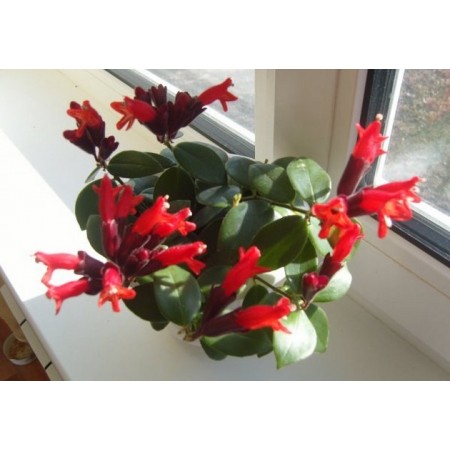Growing eschinanthus

Aeschinanthus is a plant that is quite demanding of the home environment. The representative of the flora has unique red buds and a large number of long, thin leaves. And in this material we will try to figure out how to properly care for him, achieving constant, active flowering for several seasons.
Choosing the right place
Unlike its other "brothers", eskhinantus is best placed on high shelves and in pots, rather than in standard pots mounted on window sills. This rule is determined by the need to provide the plant with a place for unhindered growth of leaves. They should fall down, so that the location at a height above the floor is ideal for him.
This place should be provided with constant access to diffused sunlight, but direct rays should be avoided. Eschinanthus can also suffer from the shadow - its leaves will begin to lose their saturation and will fall off without replenishment with ultraviolet light.
The plant can die from drafts. Sharp temperature changes are the first problem for inexperienced gardeners, so it is best to transfer the flower container to a closed room where a warm, stable temperature is maintained during the ventilation of rooms and winter colds.
Watering and humidity
Moisten the soil in the container with the eschinatus only when the topsoil begins to dry out. It is important to ensure that the soil is not oversaturated with moisture and not too dry. Depending on the temperature in the room, the amount of watering can vary (if the air in the room is warmed up to 15 and higher degrees of heat, then the pot should be watered no more than once a day).
If yellow spots appeared on the leaves of the flower, then we can safely say that the air in the room is not saturated enough with moisture. The optimal indicator is 50-60% humidity, which is acceptable for the comfort of residents.
Feeding and transplanting
The beginning of spring is a period of active budding of eschinanthus, and without the presence of additional fertilizing with mineral substances, it will be very difficult to see the flowering of this whimsical pet. Accordingly, from April to October, it is necessary to constantly fertilize the soil with special formulations, adhering to the feeding schedule at least once every couple of months.
Transplantation, as such, is contraindicated for eschinanthus, since the flower has a fairly sensitive root system. Transfer it from one pot to another follows the method of transshipment every year until the flower has matured, clearing the roots of the earth with your hands. It is necessary to perform the procedure either before its flowering (early spring), or after (mid-autumn), using universal soil for indoor plants as soil.